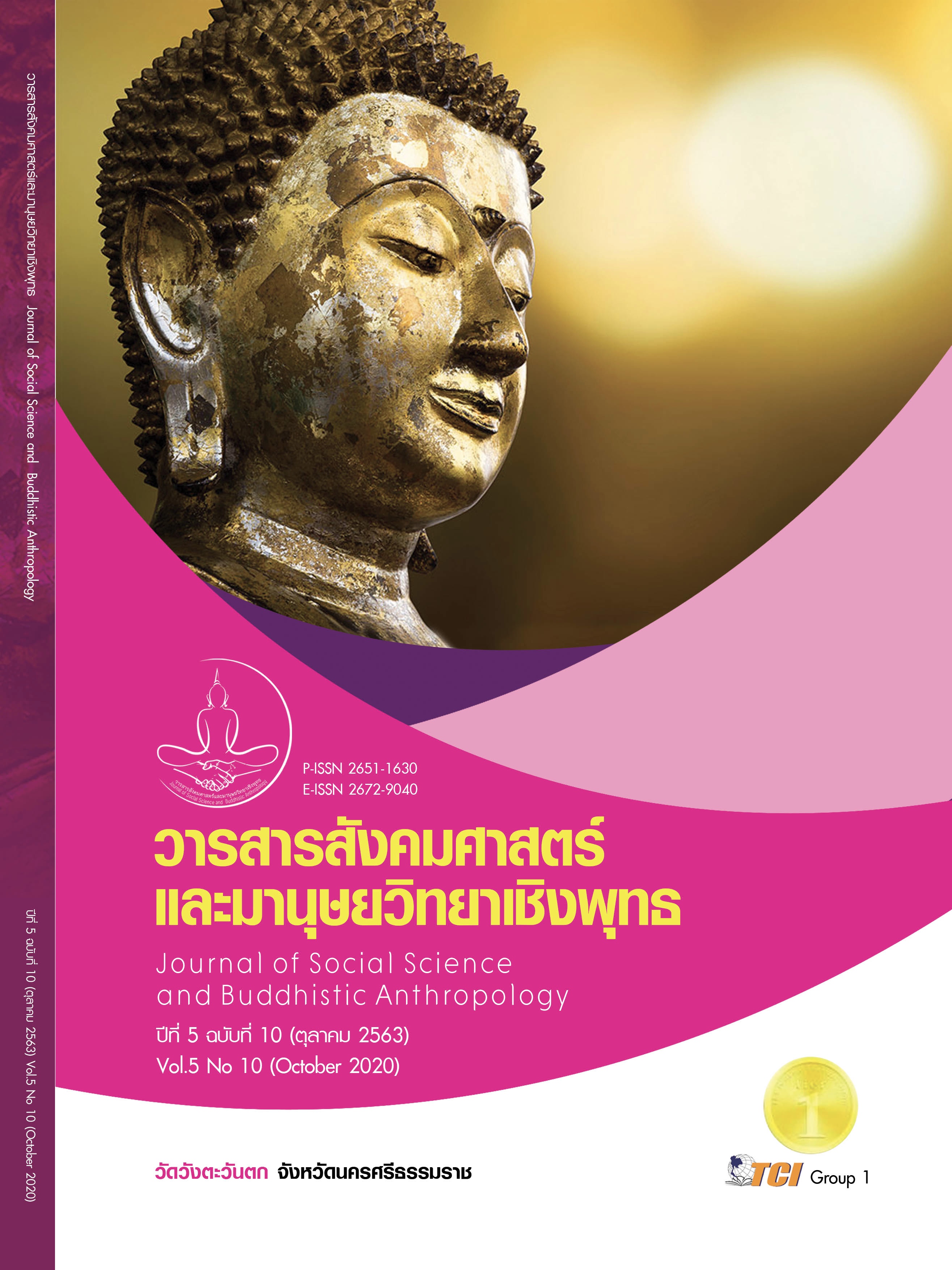CREATING A COMPUTER ASSISTED INSTRUCTION TO SOLVE THAI PRINCIPLE AND USAGE PROBLEMS OF SECONDARY SCHOOL KACHIN - THAI ETHNIC STUDENTS
Keywords:
Kachin Language, Kachin Syntax, Thai Syntax, Computer-Aided Instructional ProgramAbstract
The Objectives of this research article were to contrast the syntactic structures between Kachin and Thai languages at the phrase, clause and sentence levels by applying the Tagmemic theory, to construct the computer assisted instructional program on Thai principle and usage for Kachin - Thai students in the lower secondary school level with the efficiency of 80/80, and to compare the learning achievement on Thai principle and usage of the students before and after the implementation of the CAI. The purposive samplimg method was applied to select the sample group which consisted of 52 students at Ban Nong Khiew School and 39 students at Arunothai School in Tambon Muang Na, Chiang Dao district, Chiang Mai province. The research instruments consisted of the constructed computer assisted instruction and an achievement test with 50 sequence questions. The data were analyzed for percentage, mean, standard deviation, and the t - test for dependent sample. The research results revealed that there are differences of the syntactic structures between the two languages at the phrase, clause and sentence levels. Moreover, the accumulated scores derived from implementing the CAI were 13,673 with the percentage of 83.47 and the post-test scores derived after implementing the CAI were 3,696 with the percentage of 81.23. Therefore, the efficiency of the computer assisted instruction in the current study was 83.47/81.23. The posttest achievement scores of the students were significantly higher than those of the pre-test at the .01 level with the mean scores of 40.62 and 23.13 respectively.
References
คะนึงนิตย์ จันทุรัตน์. (2554). ภาษาศาสตร์ประยุกต์ในการเรียนรู้ภาษา. กรุงเทพมหานคร: สำนักพิมพ์มหาวิทยาลัยรามคำแหง.
ชวลิต เข่งทอง. (2560). เอกสารประกอบการบรรยายเรื่อง สื่อการเรียนการสอน. กรุงเทพมหานคร: สำนักพัฒนาเทคนิค ศึกษา มหาวิทยาลัยเทคโนโลยีพระจอมเกล้าพระนครเหนือ.
ณัฐริน เจริญเกียรติบวร และมัทนา วังถนอมศักดิ์. (2560). คอมพิวเตอร์ช่วยสอนเรื่องการทำงานของคอมพิวเตอร์สำหรับนักเรียนชั้นมัธยมศึกษาปีที่ 1 กลุ่มสาระการเรียนรู้การงานอาชีพและเทคโนโลยี โรงเรียนทีปังกรวิทยาพัฒน์ (ทวีวัฒนา) ในพระราชูปถัมภ์ฯ. Veridian E-Journal,Silpakorn University (Humanities, Social Sciences and arts), 10(2), 2088 - 2100.
ปัทมา โตอดิเทพย์. (2550). การพัฒนาบทเรียนคอมพิวเตอร์ช่วยสอน กลุ่มสาระการเรียนรู้ภาษาไทย เรื่องคำควบกล้ำ สำหรับนักเรียนชั้นประถมศึกษาปีที่ 4. กรุงเทพมหานคร: มหาวิทยาลัยศิลปากร.
พิมพ์พัชร พรสวรรค์. (2552). การพัฒนาสื่อการเรียนรู้เชิงวัตถุรูปแบบจำลองสถานการณ์ในการเรียนวิชาวิทยาสตร์ สำหรับนักเรียนชั้นมัธยมศึกษาปีที่ 2. กรุงเทพมหานคร: มหาวิทยาลัยเทคโนโลยีพระจอมเกล้าพระนครเหนือ.
พีรวัฒน์ ชัยสุข และประวิทย์ ชัยสุข. (2560). การพัฒนาบทเรียนคอมพิวเตอร์ช่วยสอน สาระการเรียนรู้ภาษาไทย เรื่องชนิดของคำ สำหรับนักเรียนชั้นประถมศึกษาปีที่ 5. วารสารครุศาสตรปริทรรศน์, 4(3), 157 - 167.
วันดี ภิญญูมิตร์. (2552). การเปรียบเทียบผลสัมฤทธิ์ทางการเรียนและความพึงพอใจในการเรียนวิชาภาษาไทยเรื่องประโยคเพื่อการสื่อสาร ของนักเรียนชั้นประถมศึกษาปีที่ 5 ระหว่างนักเรียนที่ได้รับการจัดการเรียนรู้โดยใช้บทเรียนคอมพิวเตอร์ช่วยสอนกับนักเรียนที่ได้รับการจัดการเรียนรู้โดยใช้กระบวนการ. ใน วิทยานิพนธ์ครุศาสตรมหาบัณฑิต สาขาการจัดการเรียนรู้. มหาวิทยาลัยราชภัฏพระนครศรีอยุธยา.
สุชาดา โพธิสมภาพวงษ์. (2545). การพัฒนาบทเรียนคอมพิวเตอร์ช่วยสอนเพื่อประกอบการสอนเสียงภาษาอังกฤษที่เป็นปัญหา สำหรับนักเรียนชั้นมัธยมศึกษาปีที่ 2 ของโรงเรียนพระปฐมวิทยาลัย จังหวัดนครปฐม. นครปฐม: มหาวิทยาลัยศิลปากร.
สุรีย์พร แข็งขันธ์. (2551). การใช้บทเรียนคอมพิวเตอร์ช่วยสอนเพื่อพัฒนาทักษะทางภาษา เรื่อง ชนิดและหน้าที่ของคำ สำหรับนักเรียนชั้นประถมศึกษาปีที่ 5 โรงเรียนอนุบาลดอยหลวง สำนักงานเขตพื้นที่การศึกษาเชียงราย เขต 3. เชียงราย: มหาวิทยาลัยราชภัฏเชียงราย.
Binh, D. T. (1971). A Tagmemic Comparison of the Structure of English and Vietnamese Sentences. The Hague: Mouton.
Cheung, Y. (2007). An empirical model of daily highs and lows. International Journal of Finance & Economics, 12(1), 1 - 20.
Dai, Q. & Xu, X. . (1992). Jingpo yu yufa. Beijing: Zhongyang Minzu Xueyuan Chubanshe.
Dixon, R. M. W. (2004). The small adjective class in Jarawara’, pp. 177-98 of Adjective classes: a cross-linguistic typology, edited by R. M. W. Dixon and A. Y. Aikhenvald. Oxford: Oxford University Press.
Kenneth, P. (1967). Language in relation to a unified theory of the structure of human behavior. In Janua Linguarum, Series Maior Vol. 32. Mouton.
Kurabe, K. (2012). Jingpho Dialogue Texts with Grammatical Notes. Asian and African Language and Linguistics, 7(2012), 121 - 153.
Lado, R. (1964). Language teaching: A scientific approach. New York: McGraw-Hill.
Noss, R. B. . (1964). Thai Reference Grammar. Washington: Foreign Service Institute, Department of State, United States Government.
Saville-Troike, M. (2003). Introducing Second Language Acquisition. Cambridge: Cambridge University Press.








